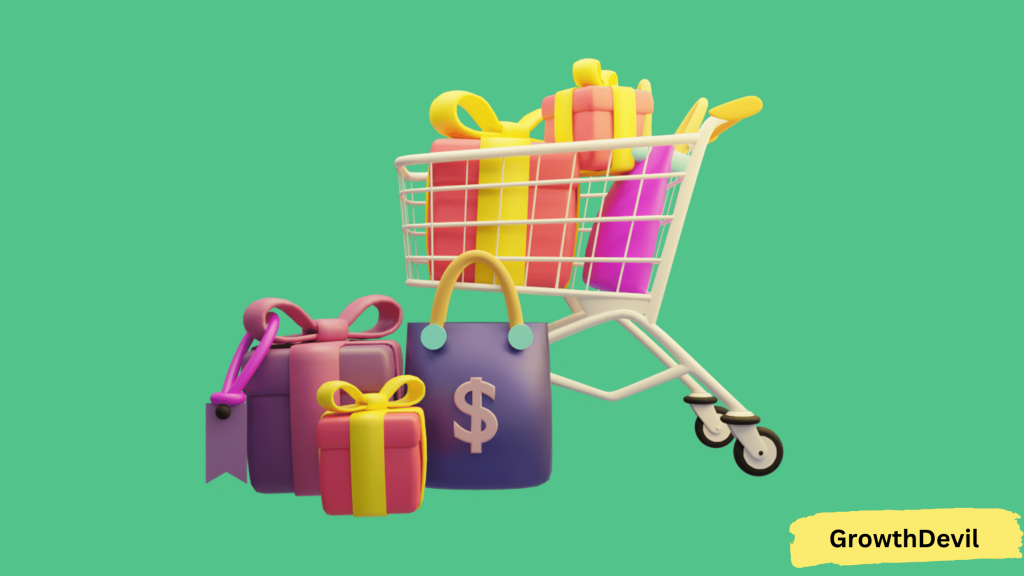There’s no doubt brick-and-mortar businesses are still making more sales, but you can’t deny the fact that online stores are constantly on the rise.
After the COVID-19 pandemic, the online retail industry took a cherished turn, with exceptional growth in online sales, with $6.151 trillion as of 2023. So, making your new career in the eCommerce sector can be fruitful.
However, the online retail industry can be as ruthless for beginners as any other business. That’s why understanding the latest statistics on online shopping is crucial to stay ahead of the competition.
In this article, we have gathered all the fascinating insights into online shopping, which will help sellers and shoppers.
Without any further delay, let’s see it.
Online Shopping Statistics You Should Know in 2025
Here are some up-to-date online shopping statistics you must know before starting your online store.
General Online Shopping Statistics

- Retail eCommerce sales are $6.2 trillion globally as of 2023. And eMarketers and experts predicted to grow sales to $7.4 trillion by the end of 2025.
- There are around 2.64 billion online shoppers in the world, which is more than one-third of the global population. Since 64.75% of the population is accessing the internet, the numbers are supposed to increase day by day.
- Only in the US, there are over 218.8 million online shoppers, which is around 65.33% of their total population. The numbers are expected to reach 230.6 million by the end of 2026.
- According to Invesp, the USA is leading the average eCommerce revenue per consumer list with $1804, followed by the UK ($1629) and Sweden ($1446).
This table shows the top 10 countries by average e-commerce revenue per user.
| Top Country | ARPU |
| The United States | $1,804 |
| The United Kingdom | $1,629 |
| Sweden | $1,446 |
| France | $1,228 |
| Germany | $1,064 |
| Japan | $968 |
| Spain | $849 |
| China | $626 |
| Russia | $396 |
| Brazil | $350 |
- The Philippines and India are the top two countries with the highest growth in retail eCommerce sales in 2022, with 25.9% and 25.5%, respectively.
- Taobao, a China-based marketplace, is the most popular online marketplace in 2022, valued at over $701 billion in gross merchandise.
This table shows the top 5 marketplaces by gross merchandise value.
| Top Marketplace | Gross Merchandise Value |
| Taobao | $701 billion |
| Tmall | $663 billion |
| Amazon | $368 billion |
| JD.com | $247 billion |
| Shopee | $78 billion |
Source: eMarketers, Oberlo, Statista, Digitalcommerce360.
Ecommerce Statistics
- As of 2023, there are over 26 million eCommerce stores running worldwide.
- There are more than 9.1 million online retailers in the world, of which 2.5 million are US-based.
- 49.7% of the shoppers considered free shipping as their top reason to buy online, while 38% of shoppers looked for discounts and coupons as of 2023.
This table shows the top reasons for shopping online in 2024.
| Top Reason | Share of Respondents |
| Free Delivery | 49.7% |
| Discounts and Coupons | 38% |
| Easy Return Policy | 33.5% |
| Customers Reviews | 29.8% |
| Easy Checkout Process | 27.9% |
| Most Likes and Comments on Social Media | 19.3% |
| Cash on Delivery Facility | 17.3% |
| Eco-Friendly Products and Companies | 16.2 |
| Interest-Free Installments | 14% |
| “Buy” Button On Social Media | 13.8% |
- Over 60% of people visit Amazon.com or Amazon’s shopping app to compare the price of a product.
- As of 2023, E-commerce sales account for 21.5% of total retail sales globally. And the numbers are expected to reach 23.6% by the end of 2025.
- Compared to large retailers, small online retailers will be seeing a 29% higher mobile conversion rate in the near future.
- 88% of shoppers think that detailed product pages are critical for deciding whether to purchase from a website or not.
- 38% of shoppers instantly leave a website without shopping if it looks ugly or unattractive.
Source: Oberlo, Instapage, Optinmonster.
Mobile Shopping Statistics

- Approximately 66.5% of total e-commerce sales are made through mobile devices as of 2023, and these numbers are expected to reach 67.6% by the end of 2025.
This table shows the share of m-commerce sales in total e-commerce sales from 2020 to 2025.
| Year | Share of m-commerce sales |
| 2025* | 67.6% |
| 2024* | 67.1% |
| 2023 | 66.5% |
| 2022 | 65.7% |
| 2021 | 64.9% |
| 2020 | 64.1% |
*Projected
- Mobile devices generated the highest traffic among all devices, with 74% as of 2023. Also, mobile devices account for 63% of all order share.
This table shows the traffic and order share by device.
| Share | Mobile | Desktop | Tablet |
| Traffic Share | 74% | 24% | 2% |
| Order Share | 63% | 35% | 2% |
- According to the National Retail Federation, 63% of mobile shoppers think new shopping technologies and innovations (such as AI-based customer support, personalized messaging, chatbots, etc.) improved their shopping experience.
- While shopping inside a physical store, 65% of the shoppers look up their smartphones to compare prices, 61% look for product information, and 49% for online reviews.
- Globally, m-commerce generated $4.089 trillion in retail sales as of 2023.
This table shows the global retail m-commerce sales from 2020 to 2025.
| Year | The Global Retail M-commerce Sales |
| 2025* | $4.999 trillion |
| 2024* | $4.541 trillion |
| 2023 | $4.089 trillion |
| 2022 | $3.643 trillion |
| 2021 | $3.203 trillion |
| 2020 | $2.721 trillion |
*Projected
- 68% of total eCommerce traffic was generated through smartphones in the first quarter of 2023.
- Only 12% of consumers find mCommerce convenient, while 86% think that the mobile shopping experience can be improved.
Source: eMarketers, Statista.
Impact of COVID-19 on Online Shopping
- The total retail sales increased by 19% from 16% during COVID-19 in 2020.
- Compared to 2019, online grocery sales rose to 103% in 2020.
- Hotel bookings, travel, tourism, and flight tickets saw the biggest fall (75% loss) during the COVID-19 pandemic.
- According to Morning Consult, 37% of shoppers anticipated spending more on daily goods from online marketplaces due to COVID-19.
- Instead of going to restaurants, 31% of consumers preferred buying food online.
- On Etsy, the number of face-mask sellers grew 5X higher in the span of two weeks due to high demand.
- A survey shows that 37.2% of people (who had never shopped before) started purchasing online at least once a week.
Source: UNCTAD, Forbes.
Online Shopping by Category Statistics
- Globally, fashion is the top online category with $990.8 billion in sales, followed by electronics and media ($960.3 billion), hobby, toys, and DIY ($683.8 billion), food, beverages, and personal care ($568.6 billion), appliances and furniture ($504.9 billion).
- The computer and consumer electronics category accounted for $219.33 billion in sales in the United States as of 2023.
This table shows the top e-commerce categories in the United States by revenue.
| Category | Revenue | Share of total e-commerce sales |
| Computer and Consumer Electronics | $219.33 billion | 21.2% |
| Apparel and Accessories | $203.75 billion | 19.7% |
| Furniture and Home Furnishing | $129.45 billion | 12.5% |
| Health, Personal Care, and Beauty | $111.03 billion | 10.7% |
| Auto and Parts | $86.26 billion | 8.3% |
| Food and Beverage | $78.28 billion | 7.6% |
| Toys and Hobby | $74.03 billion | 7.2% |
| Books/Music/Video | $54.02 billion | 5.2% |
| Office Equipments and Supplies | $19.35 billion | 1.9% |
| Other | $58.32 billion | 5.6% |
- 60% of shoppers prefer buying video games, books, movies, and music online to physical stores.
- The household-supplies purchases increased by 24% due to quarantine in COVID-19.
- In Asian countries, the most popular categories are packed groceries and goods (40.2%), home care (37.5%), fresh groceries (35.4%), and video gaming (29.9%).
- Globally, 30% of electronics and computers are purchased online.
- This year’s growth rate (13.2%) is comparatively lower than last year’s (31.1%).
Source: eMarketrs.
Social Shopping Statistics
- According to Adweek, 87% of online consumers consider social media as the most crucial factor while making decisions for purchases.
- As of 2023, retail social commerce sales sales are $56.17 billion in the United States, which is 22.8% more than in 2022.
This table shows the social commerce sales in the United States from 2019 to 2025.
| Year | Social E-commerce Sales |
| 2025* | $79.64 billion |
| 2024* | $67.32 billion |
| 2023 | $56.17 billion |
| 2022 | $45.74 billion |
| 2021 | $36.62 billion |
| 2020 | $26.97 billion |
| 2019 | $19.42 billion |
*Projected
- Globally, social commerce sales are $1,289 billion as of 2023.
This table shows the social commerce sales worldwide from 2022 to 2026.
| Year | Social Commerce Sales |
| 2026* | $2,900 billion |
| 2025* | $2,221 billion |
| 2024* | $1,698 billion |
| 2023 | $1,298 billion |
| 2022 | $992 billion |
*Projected
- 55.5% of shoppers are aged between 18 to 24 who have made purchases through social channels.
- China is expected to reach the mark of 450 million social buyers by 2023. That’s why no country is nowhere near China when it comes to social commerce.
- Facebook is the top social commerce platform, with 56.1 million shoppers in the US. 85% of total social purchases are made through Facebook.
- Globally, Facebook has 65.7 million social buyers as of 2023, and these numbers are expected to reach 71.1 million by the end of 2026.
This table shows the number of social buyers worldwide as of 2023 by social media platform.
| Social media platform | 2022 | 2023 | 2024 | 2025 | 2026 |
| 63.5 million | 65.7 million | 67.8 million | 69.4 million | 71.1 million | |
| 41 million | 43 million | 45.3 million | 47.5 million | 49.7 million | |
| 15.9 million | 16.9 million | 17.5 million | 18.1 million | 18.8 million | |
| TikTok | 23.7 million | 33.3 million | 35.8 million | 37.8 million | 39.5 million |
- China’s WeChat by Tencent accounts for $115 billion in revenue in social sales.
- According to Forbes, 30% of social shoppers purchase branded products from Instagram, Snapchat, Pinterest, and Twitter.
- 23% of social users believe in online reviews and recommendations before buying from a social platform.
Source: eMarketers, Oberlo.
Shopping on Amazon
- 89% of shoppers prefer to buy from Amazon compared to other marketplaces.
- 63% of adults start their search on Amazon when shopping online in the United States.
- Amazon records more than 2.5 billion monthly visitors and 200 million unique visitors per month.
- Around 98 million shoppers access the mobile app at least once a month to shop from Amazon.
- Amazon is expected to account for over 50% of all eCommerce sales in the US.
- In the second quarter of 2023, Amazon generated $134.383 billion in revenue, which was 10.85% more than in the first quarter.
This table shows the Amazon’s revenue from 2020 to 2023.
| Year | Amazon’s Revenue |
| 2023 (As of Q2) | $261.741 billion |
| 2022 | $513.983 billion |
| 2021 | $469.822 billion |
| 2020 | $386.06 billion |
| 2019 | $280.522 billion |
| 2018 | $232.887 billion |
| 2017 | $177.866 billion |
| 2016 | $135.987 billion |
- There are over 220 million Amazon Prime users in the world. 35% of Amazon shoppers believe Prime is the best app for online shopping as it offers fast shipping options.
- 66% of shoppers look for brands on Amazon instead of official websites.
- In the second quarter of 2023, AWS’s revenue was $22.1 billion. As of 2023, AWS generated $43.45 billion in revenue. AWS generated $80 billion in revenue in 2022.
- Amazon records an average daily sales revenue of $1.29 billion.
Source: eMarketers, Microtrends, Yaguara, CNBC.
Abandoned Shopping Cart Statistics

- 80% of all online shopping carts are abandoned by customers. The reason is product availability and competitive prices on online stores.
- As of August 2023, e-commerce abandonment rates on mobile devices were 78.08%. Abandonment rates vary by device, industry, and region.
This table shows that e-commerce abandoned rates by device.
| Device | August 2023 | July 2023 | June 2023 | May 2023 | April 2023 |
| Mobile | 78.08% | 76.64% | 76.59% | 76% | 78.07% |
| Desktop | 61.55% | 58.04% | 63.95% | 59.05% | 65.08% |
| Tablet | 71.03% | 62.61% | 63.01% | 62.34% | 69.83% |
- 55% of shoppers abandon the carts due to the extra costs, followed by account requirements (34%) and longer checkout time (26%).
- Abandoned cart emails see an average of 15.22% conversion rate, which makes it the best way to seal the deal after abandoned carts.
- Slow deliveries are responsible for 36% of abandoned carts. However, according to 40% of respondents, the primary reason is impaired website functionality.
This table shows why people abandon their carts.
| Reasons | Share of Respondents |
| Impaired Website Functionality | 40% |
| Delivery too slow | 36% |
| Concern about quality | 35% |
| Not sure about the fitting of the clothes | 35% |
| Found a better Price | 33% |
| Product Appearance | 30% |
| Can’t Find Items | 30% |
| Security Concerns | 30% |
| Return Policy | 27% |
- Checkout popups averted 53% of consumers from abandoning their carts.
- To get free shipping, 24% of shoppers add more products to their carts.
- Online retailers lose $4.6 trillion due to the abandonment of carts worldwide.
Source: Dynamic Yeild, ThinkShop.
Black Friday and Cyber Monday Statistics
- Over 187 million US-based users shop during Black Friday and Cyber Monday sales. People spend an average of $335 on these occasions.
- An average person in the United States plans to spend $500 between Cyber Monday and Black Friday.
- Consumers spent $11.3 billion on Cyber Monday in 2022.
- 15.6% of holiday season sales came from Cyber Monday in 2022.
- 93% of millennials aged between 24-35 shop this weekend, spending an average of $420 per person.
- 58% of all shoppers purchase online during this weekend, while 51% like to purchase from physical stores.
- 40% of shoppers considered purchasing early to avoid out-of-stock situations.
- Holiday seasons brought up to $200 billion in revenue in 2021.
- BNPL (Buy Now, Pay Later) services saw a whopping 500% growth due to early holiday sales.
- Smartphones accounted for 43% of all Cyber Monday sales.
- Holiday season sales saw a record-breaking growth of 44% in 2019.
Source: Exploding Topics, eMarketers.
Technology Shopping Statistics
- According to Smallbizgenius, 85.3% of online interactions with shoppers were handled by AI and bots.
- 51% of e-commerce businesses adopted AI as of 2023.
- AI and Chatbots can boost the average number of orders by 26%.
- 60% of shoppers use chatbots to find products and answers to their common problems.
- 20% of products searched on Google are made via AI voice assistants.
- 80% of e-commerce and retail businesses have adopted or have plans to adopt AI in the future.
- 95% of chatbots take an average of 5 seconds to provide solutions regarding any issues instantly.
- 20% of consumers are willing to buy products and services from a Chatbot.
- 66% of users use AI technologies and voice bots to purchase and checkout in physical stores.
- 11% of smart-speaker users (like Alexa and Amazon’s Echo) used voice commerce technology to order products online.
- 25% of shoppers used smart speakers to search for products on different marketplaces.
Source: Gartner, Businessinsider.
Related Read:
Bottom Line: Online Shopping Statistics (2025)
Globally, online shopping has grown significantly recently. And it is predicted to continue in the future.
These online shopping statistics indicate the growing popularity of online shopping worldwide. It is high time to start an online business due to the growing e-commerce market.
I hope you have found this article helpful. For the latest update, keep revisiting this post. We will be updating it from time to time.
FAQs
A recent study on the number of online shoppers shows that 33.33% of the world’s population shop online as of 2023, which is accounting for 2.64 billion people.
In the United States, millennials are the largest demographic group that shops online the most. 41.8 million millennials will shop online in 2024.
The COVID-19 pandemic has impacted online shopping positively. Many new consumers started shopping online during the pandemic.
The global online shopping market size was $2.66 trillion in 2022, and it is expected to grow at a CAGR of 11% and reach $6.2 trillion by the end of 2030.
According to Statista, 44% and 34% of consumers in the United States buy clothes and shoes the most online, respectively.
- Shopify 3 Months For $1 (DEC 2025) – 90 Days Trial - October 3, 2025
- Helium 10 Free Trial (2025) — Access Premium Features - September 4, 2025
- Jungle Scout Free Trial (2025) — Get 7 Days Access Now - September 4, 2025


